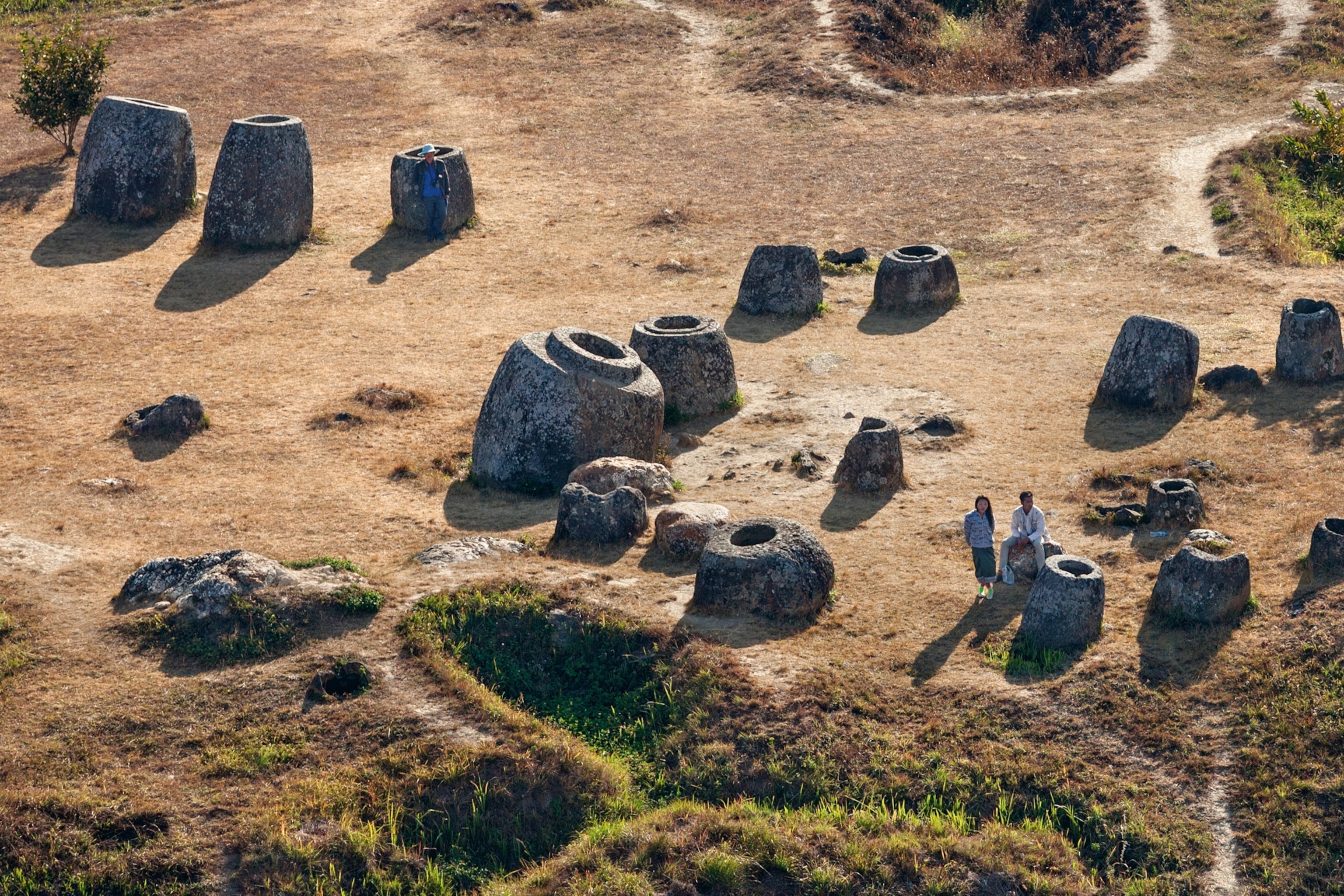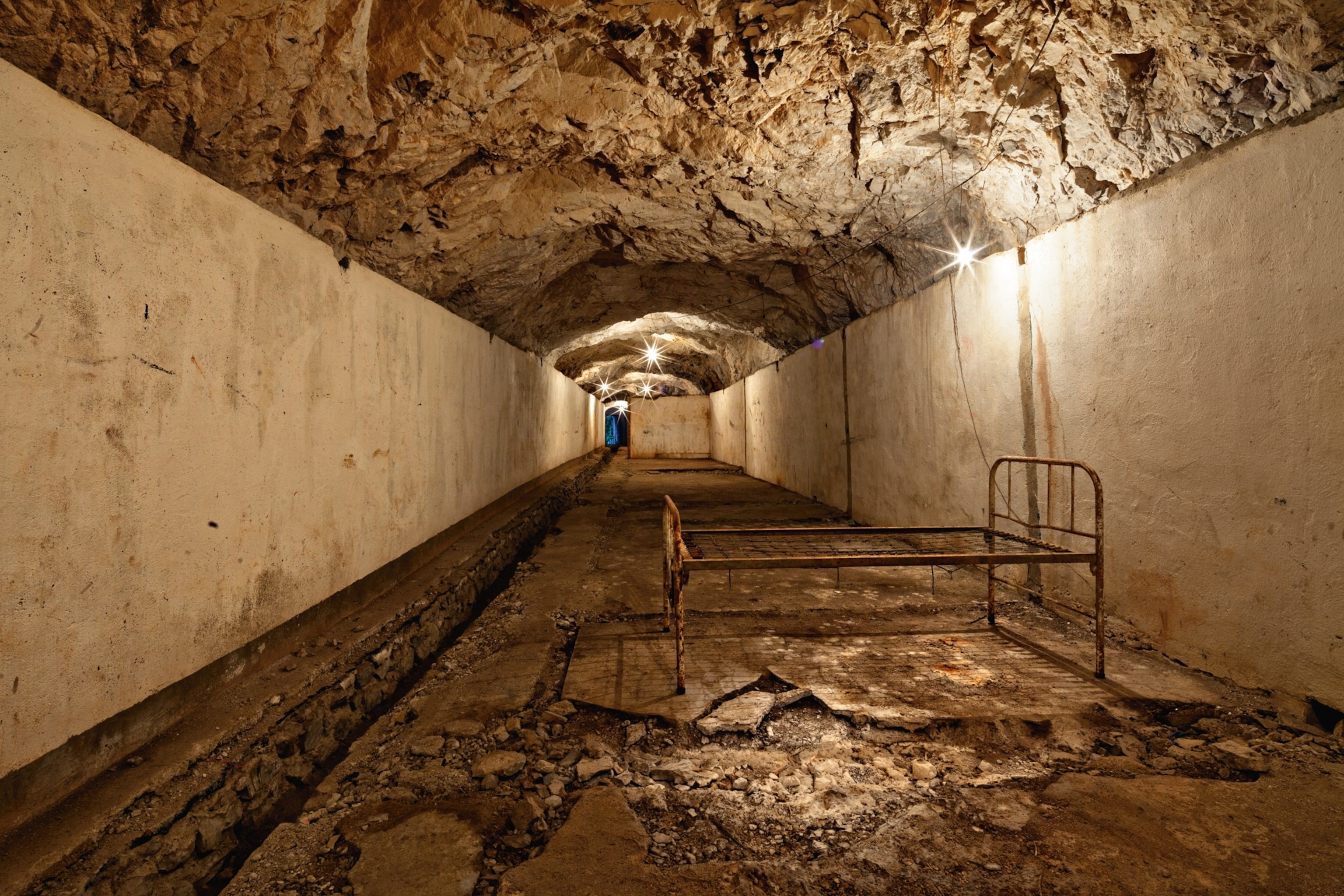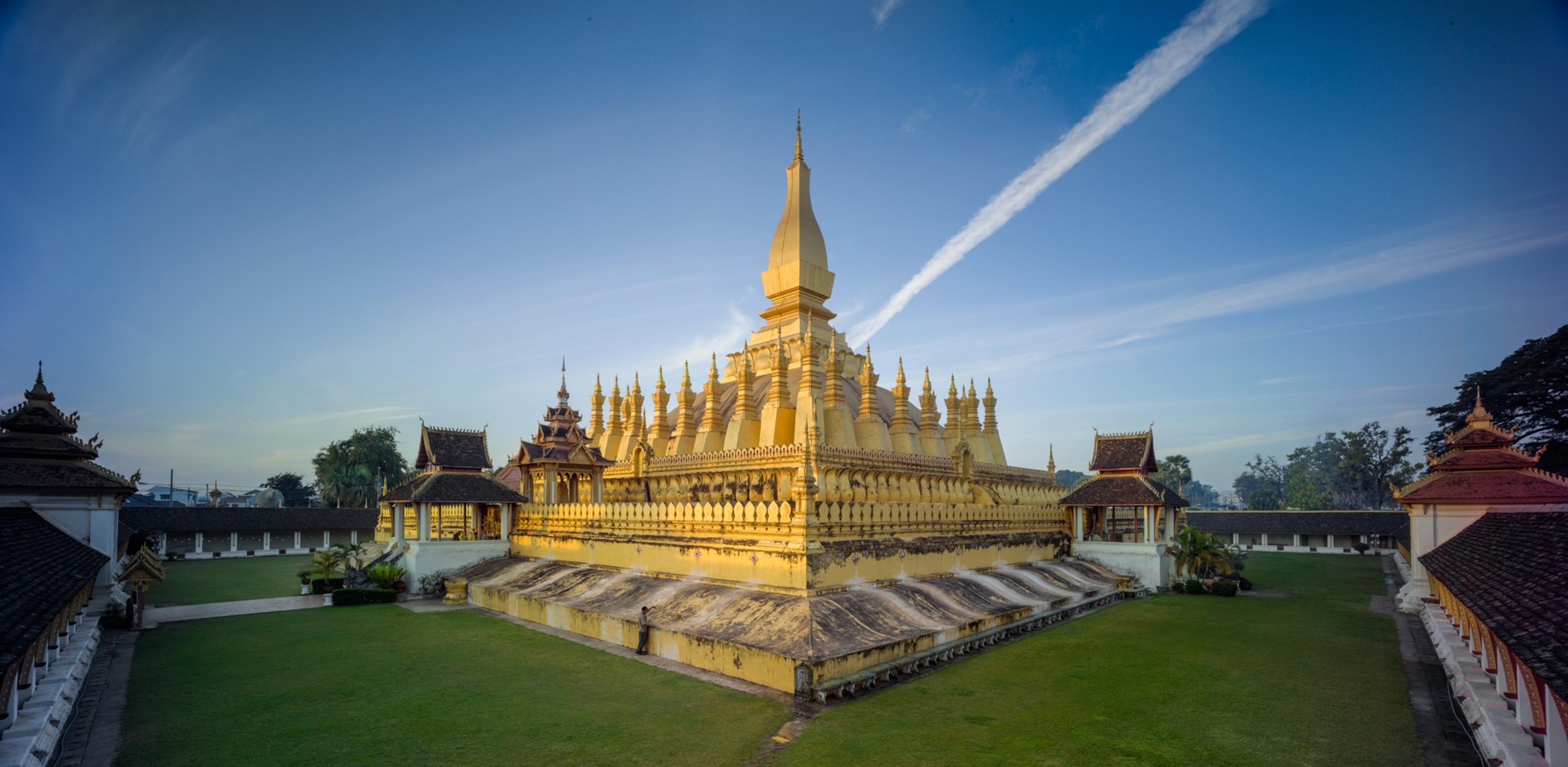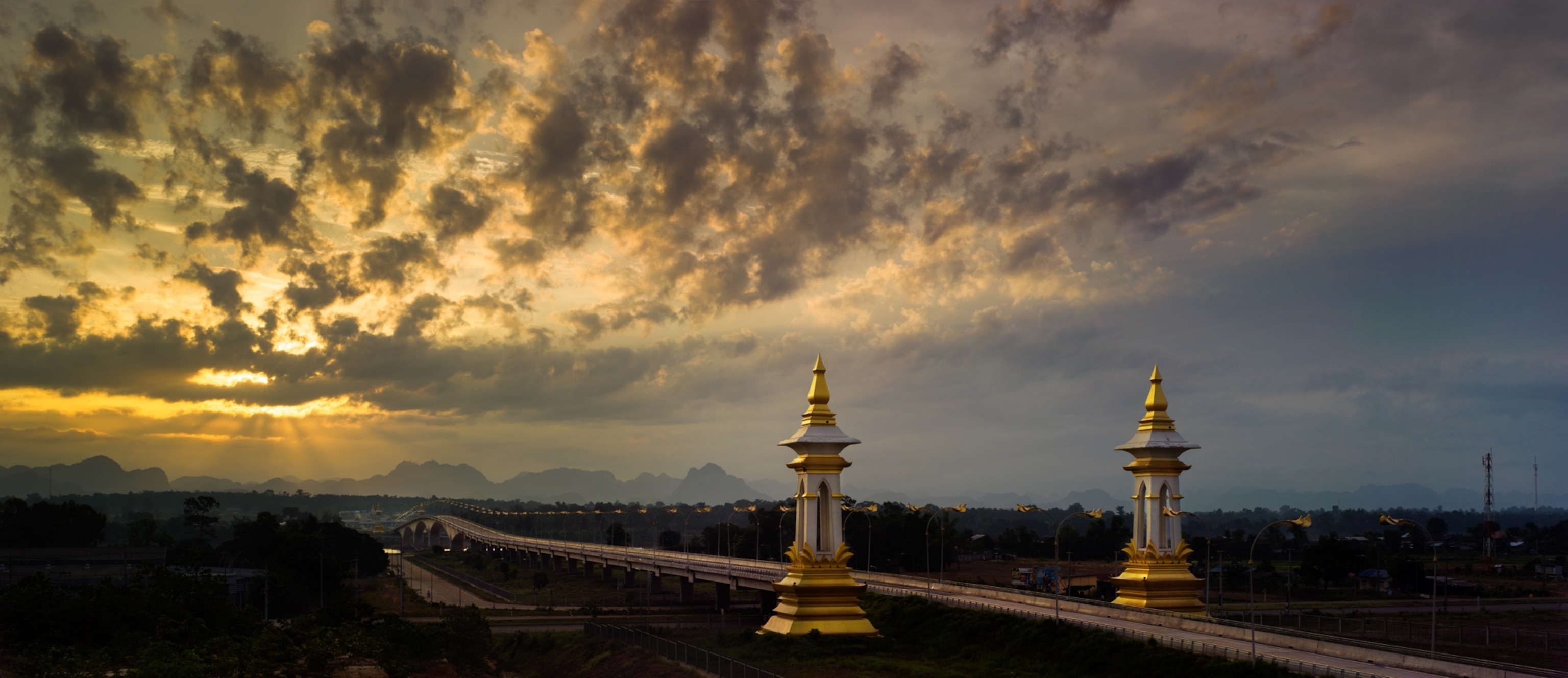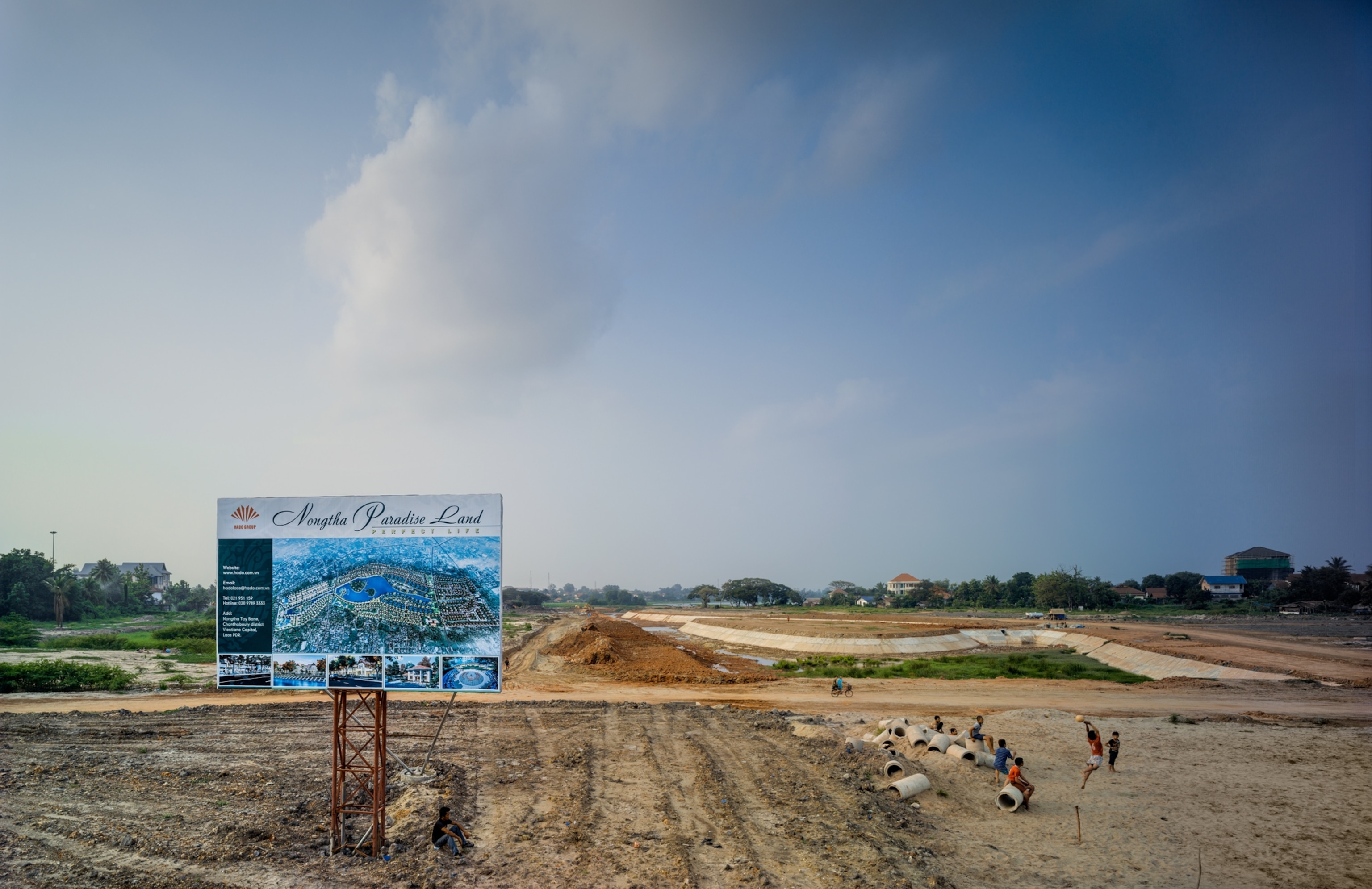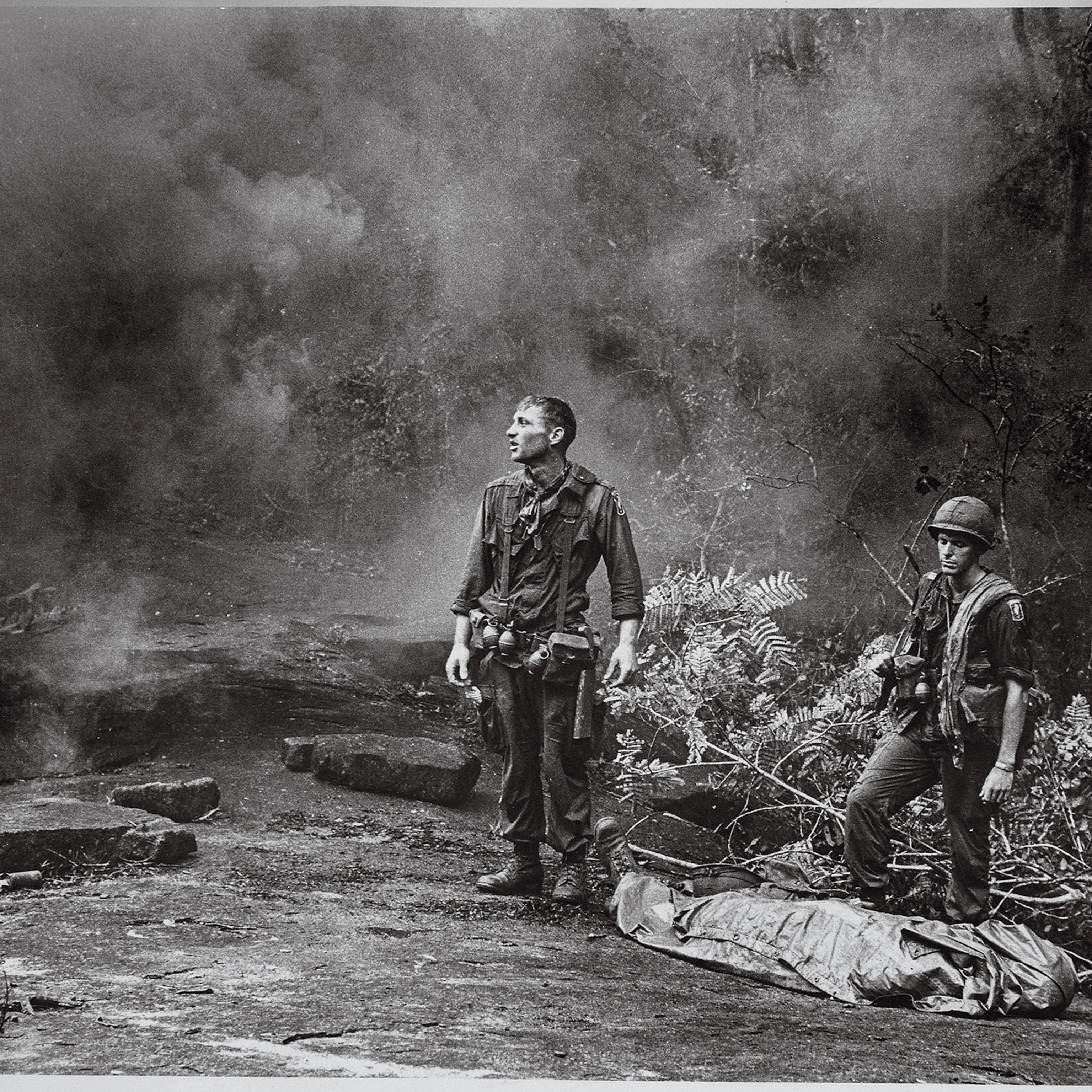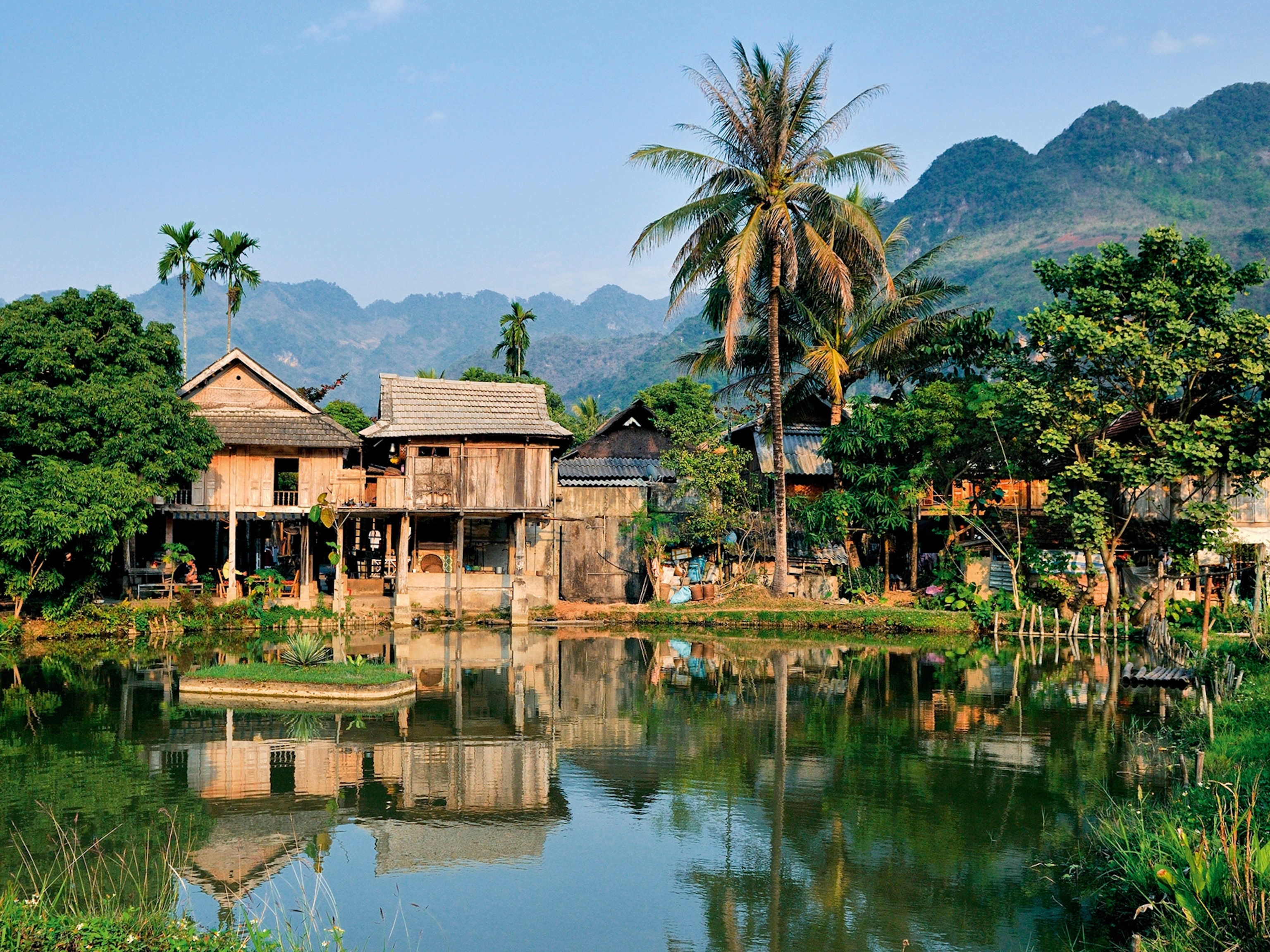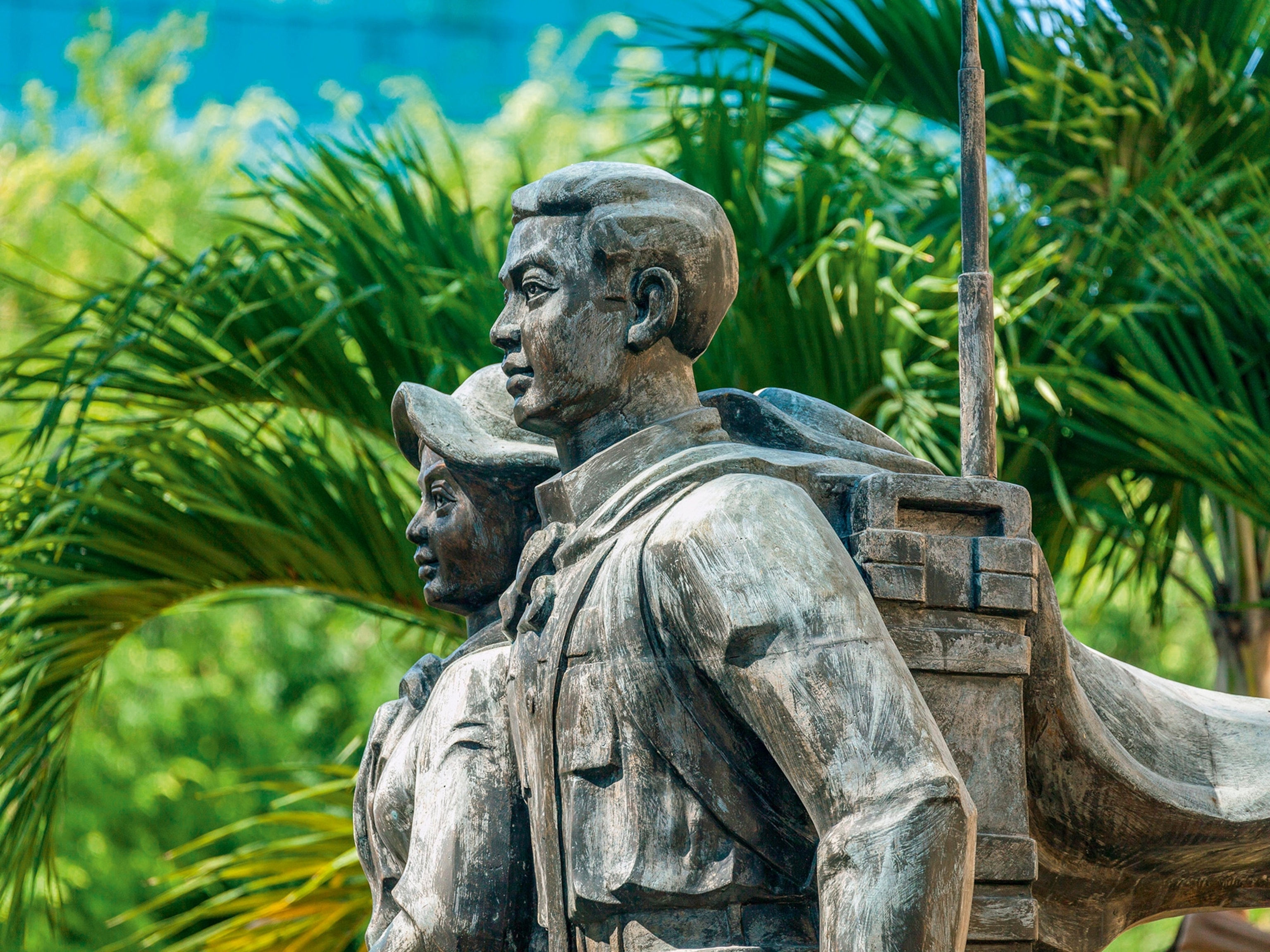Laos Finds New Life After the Bombs
The U.S. dropped more than 2 million tons of bombs on Laos from 1964 to 1973 during the Vietnam War. That’s equal to a planeload every 8 minutes for 9 years. How does a country recover?
For days up there on the Plain of Jars I’d been trying to capture an image, find a metaphor, crystallize an idea that could convey what it means for Laos to have been one of the most heavily bombed nations in history and then to have gone on and somehow found a future. Finally, right there on a busy main street of Phonsavan, the provincial capital, I found it: a giant pile of bomb casings left over from the American bombing campaign in Laos, a stupendous and futile torrent of airborne destruction. And just beyond the junk heap of weaponry, a new ATM machine. Bright blue and gleaming white, this beckoning pagoda of money dwarfed the rusting debris of a half-forgotten war. After inspecting the bomb casings, I walked over to the ATM, stuck in my debit card, and pulled out one million kip, about $120. All those 50,000-kip notes spewing out of the machine told a new story about Laos, where an age of bombs has given way to an age of money.
Once, here in Xiangkhouang Province, children grew up barely seeing the sun. People spent years hiding in caves and tunnels. Now Phonsavan is so busy it has traffic lights with digital displays showing how many seconds pedestrians have to cross the street—not that you need cross the street to find a bank, a restaurant, a market full of fresh fruit and vegetables, a shop selling running shoes. Along with the fabled megalithic urns on the Plain of Jars, whose purpose still mystifies archaeologists, the debris of the American air war that lasted from 1964 to 1973 has become part of a public relations campaign to attract tourists: That heap of bomb casings is displayed in front of the local tourism office.
With its undulating hills and grassy flatlands, the Plain of Jars in some places resembles a giant golf course. The sand traps here were made by falling bombs, millions of which exploded. Millions more did not, creating a permanent danger, especially to those entrepreneurial Laotians who make money salvaging valuable metal from unexploded bombs.
“Welcome to Mr. Phet Napia Making the Spoon and Bracelet,” announces the ad on Phet Napia’s house in the village of Ban Naphia. In his backyard foundry Phet melts aluminum from ammunition shells and locally collected metals. He then pours it into a mold to create bomb-shaped key rings as well as eating utensils. Local restaurants all seem to have forks, spoons, and chopsticks made of war-era scrap metal.
The fruits of Phet’s industry are on show: a new house, a satellite TV, electric lights. Like many Laotians, Phet is an artisan with a flair for entrepreneurship, but he’s still trying to get his mind around the idea that in a market economy the costs don’t stop when you pay for something. “You get 60 channels on it,” he said as we admired his satellite dish, “but you must pay for the electricity.” His mobile phone helps attract new business, “but even after you purchase it, you must pay to talk into it also.”
A Picture of Vibrancy
Laos, with a population of fewer than seven million, now has almost five million mobile phones. At Ban Pak-Ou, a northern village on the Mekong River, fishermen stand motionless in their pirogues silhouetted in the amber light, the water around them glimmering like burnished bronze. It’s like peering back through the centuries, except that each man is chatting into his cell phone as he fishes.
Vientiane, the capital, once was a scruffy town. Now it’s a scruffy city with 12-story buildings. Once silence prevailed, punctuated by the sounds of falling rain, babies crying, people laughing, monks chanting. Today everything happens in a soupy buzz of air conditioners clattering, generators buzzing, motorbikes whining, horns blaring.
The country’s economy is growing by nearly 8 percent a year. The flag of the Lao People’s Revolutionary Party, with its Soviet-style hammer and sickle, still flies alongside the national flag, but the government’s leaders, whose role was once to enable the Vietnamese to pursue their Marxist-Leninist war of national unification, now play a different part: as enablers in the creation of a Southeast Asian free-market zone. Laos aims to graduate from the ranks of the least developed countries on the UN’s list by 2020.
In Laos the rich are getting richer, and even in the remotest areas, among the humblest people, I encountered an access to possibilities of the outside world previously unimaginable. Near the Vietnamese border in central Laos, I saw a young man heading home on his motorbike with a satellite dish cupped under his arm. In mountain villages I saw flocks of schoolchildren in their white-and-blue uniforms. I also saw refurbished places of worship wherever I went—Buddhist temples, to be sure, but also many animist shrines and a few Christian churches. You still see monks in their saffron robes everywhere, only now they carry computer bags.
The Mekong still flows past Vientiane broad as history, but the riverfront has been transformed. Once a series of mud banks and sandpits, it’s now an inviting esplanade almost two miles long, complete with exercise machines and jogging paths—and parking spaces for all those family sedans and SUVs. Every evening brings a throng: the lovers, the jugglers, the laughing children, the break-dancers. Musicians perform, and exercise gurus offer classes, as the immense disk of the setting tropical sun turns itself into a blurry horizontal streak, and the hubbub is illuminated by the neon tubes on the vendors’ pushcarts and the shifting beams of motorcycle headlamps.
Like most things in Laos, this riverside park in Vientiane tells a deeper story. A triumph of humanist city planning—which has refocused life on the river, the open space, and the sky—the esplanade is actually a massive levee protecting the city from flooding. Who built it is also revealing: It was funded largely by a loan from South Korea. The countries of Asia now provide more useful assistance than the Occidental powers ever did.
During all the time France and the United States predominated in Laos, neither country built a bridge across the Mekong. Today six great bridges span the river. One is at Thakhek, where the transit distance across Laos between the growing economies of Thailand and Vietnam is shortest, only 90 miles. In Thakhek I could see Thailand through my hotel room window while watching Vietnam Idol on TV.
One morning in Vientiane I found a motorcycle club had filled the lobby of my hotel. “We’re on a joyride from Malaysia,” one biker politely explained—a 2,600-mile round trip. Another morning, this time in Louangphabang, I awoke to find the street outside crammed with newly arrived cars. Every one had a Chinese license plate. While those affluent bikers from Kuala Lumpur were heading north, affluent Chinese from Kunming were heading south, taking a Laotian vacation too. Just as the domino theory had predicted, Laos was being invaded, though by Peugeots and Harleys, not communist tanks and armored personnel carriers.
This new era of peaceful interconnectedness has a human face everywhere you go. Its contours are also visible from the air. Flying over the Mekong from Savannakhet, you see another of those bridges conveying people and products into and out of Laos. Just upstream from it you also see skyscraper-high pylons carrying the electricity Laos exports across the river. Once when I flew out of Louangphabang, bomb craters caught my eye. Now there are other gouges—sand traps at the new golf course South Koreans have built.
A City’s Rebirth
Decades ago when I stood on the riverbank in Vientiane, I pondered a question I knew I’d never be able to answer. How could seemingly rational people—Americans like me—imagine they could win the war in Vietnam by subjecting Laos to such indiscriminate destruction? When I wrote that a secret war was being fought in Laos, it made headlines around the world. In truth the U.S. military intervention in Laos, which began in the 1950s and lasted until 1974, never had been secret. All you had to do was ask any Laotian what was happening in the country. Every lady selling lotus blossoms in the morning market, every rickshaw boy offering you every imaginable enticement, knew all about not just the Ho Chi Minh Trail but the secret CIA army and the secret U.S. bombing of civilian populations. They also knew about the secret U.S. involvement in the opium trade.
In 1968, the year of the Tet Offensive in neighboring Vietnam, I took a group taxi from the Mekong lowlands to the Bolovens Plateau. When the driver refused to go farther, I walked on. U.S. fighter bombers screeched overhead. On the horizon, along the tree line, I saw scurrying figures in camouflage. It was the only time during the war that I actually saw North Vietnamese troops—or U.S. warplanes dropping bombs. I was 23, yearning to uncover the truth.
At Pakxong, a former French outpost for coffee growers, I wandered into an abandoned bar that could have been lifted from a Foreign Legion movie. A mural showed French planters taking their ease in the company of comely Laotian women. It was dark, and the only sign of life came from a small house next to the old French church. Inside the house I met a one-legged French priest drinking whiskey, his wooden leg propped up against a table. He filled a glass for me. He was reading a French translation of The Green Berets, a fictional tale of American derring-do in the jungle. “Is this what the Vietnam War is like?” he asked.
For decades I’d wanted to see Pakxong again. I knew the priest would no longer be there, but I hadn’t expected that old Pakxong would be gone too. Following my 1968 foray, B-52s had carpet bombed it twice. Only the charred corner of one building remained. In its ruins I could make out faint initials: EDL. It had been the local office of the Laotian electric company.
Pakxong had been obliterated, so why did returning there fill me with a kind of joy? It was the people—seemingly so peppy and happy—busily making a better life. Like Laos itself, Pakxong had been transformed from a battlefield into a marketplace. Where the French cantonment had been was now a sprawling market—chaotic, muddy, littered with plastic and organic refuse, but displaying anything you could want to sell or buy. What fascinated me most was the iron buffalo.
Imagine you’re a Laotian peasant entrepreneur and you want everything you’ve seen on TV, but all you can afford is one thing. The iron buffalo is for you. Unlike a water buffalo, the iron buffalo can pump water as well as pull a plow, and it can light your house. It’s basically a multipurpose, portable internal combustion engine you can use to power almost anything. Connect it to your pump: You can grow dry-season crops. Connect it to your plow: You can quadruple the land you cultivate.
Connect your iron buffalo to your cart, and a two-day walk to and from the nearest big market center becomes a morning’s expedition. That’s how I met Lan Keopanya. He had bolted a Volvo steering wheel to his iron buffalo, which he’d attached to his rubber-tired cart. He was cranking up his homemade pickup truck when we started talking. His village, he said, was 12 miles from the Pakxong market. “The journey costs four liters of diesel, but it’s worth it.” By getting there so much faster and more often, he could sell the coffee, fruit, and vegetables he grew at the best price. That day Lan was there buying plastic roofing for his new house. All his six children were or would be going to school, he told me proudly. A new road already reached his village. “We expect electricity within two years,” he said, as he began moving, hurrying to get that roofing up before the rains began.
In parting, I asked what he wanted next. “We need our land to be cleared of bombs,” he said. “If it weren’t for the bombs, I could multiply my production.”
During the bombing the mountain minorities of Laos suffered horribly. In the end it no longer mattered what side you took. The bombs didn’t distinguish between communists and anticommunists any more than they distinguished between soldiers and children. As the bombing accelerated, women used their expertise in embroidery and quilting to depict the catastrophe that fell out of the sky on them. With their images of bleeding children, burning crops, and terrified animals, their wall-size works of art are Laotian equivalents of Pablo Picasso’s “Guernica.”
Keay Tcha, who told me she was 58, has lived for more than 17 years in Ban Na Oune, a Hmong refugee resettlement located near Louangphabang. She unfurled one of her peacetime masterpieces for me. It depicted an unlost paradise where sparkling waters ran, luxuriant plants flourished, and a Noah’s ark of exotic animals cavorted under a benign, multihued sun. In her hands a scrap of polka-dot cotton became a giraffe. A blue rag became a flowing stream. When I asked to see more, she told me she no longer worked on that scale. “The tourists don’t want big tapestries,” she said. “They want inexpensive embroidery they can take home in their hand baggage. So now I make many small things I can sell for a lower price.” She passed no value judgment on this latest transformation. She was surviving the peace as she’d survived the war, by recognizing what was necessary and doing it.
A New Drug Problem
One thing never changes in Laos: the heat of the journey. My quest for a cold drink brought me to Khenchan Khamsao’s convenience shop, on the north-south road to Louangphabang. A glass-doored, refrigerated drink dispenser beckoned, but it was her forest green trash container that got us talking. With its shapely pedestal (to keep away vermin), capacious bin, and secure lid, Khenchan’s trash container was graceful as well as utilitarian. “They make them from worn-out truck tires,” she explained. Like Phet Napia’s spoons and bracelets, the bin was an example of the Laotian genius for turning castoffs into useful objects.
Her own life had been fashioned out of wreckage. She had come from a devastated section of Khammouan Province in central Laos, where many places remain so littered with unexploded ordnance (UXO) that it’s impossible to farm there. Because their land was unusable, she and her husband migrated to this wide spot in the road; 12 years later they epitomized the Laotian success story. Their shop occupied the ground floor of their new house. Her husband earned money as a construction worker on an irrigation project at Vangviang, 65 miles to the north. Their three children were studying in government schools—the young ones locally, the eldest in Vientiane.
Khenchan and her family had lived the bombs, and now they were living the money. Money, they’d discovered, brought danger too. When I remarked that in the capital her son would get a better education, she replied, “No, that wasn’t why we sent him away. I sent him to Vientiane to get him away from the drug dealers.” A war on drugs started in 1989 with U.S. funding to eradicate opium. In 2006 Laos declared itself opium free, but as the economy boomed, an appetite for methamphetamines and other designer drugs took hold. The country is a major regional transit center for methamphetamines, heroin, and opium, which is again on the rise. As in America, rural areas have been especially hard hit.
Haunted by Falling Bombs
In Laos when the temperature goes below about 70 degrees, people start pulling on their coats and hats and lighting fires, which ignites the season of death. One New Year’s Eve three friends in Xiangkhouang Province went camping. It got cold that night, so they started a fire. One was killed right away when the bomb under their campsite exploded. Another was terribly maimed. I visited Yer Herr, the third victim, at his village home. The 18-year-old pulled off his shirt to show me 19 wounds on his back.
In Yer’s village people had electricity, satellite TV, mobile phones. Each mother, wife, sister, and child, it seemed, also had a husband, a brother, or a little girl who had been maimed or killed by American bombs long after the end of the war. At the local high school, algebra was being taught on a blackboard. I couldn’t decipher the equations: Laotian teenagers in this remote village were learning mathematics more advanced than I’d been taught at their age in America. Back home, I showed a photo of that blackboard to a mathematician. “It analyzes the velocity of falling objects, like bombs,” he told me.
Falling bombs still show up in dreams as well. “I live it inside me,” a world-renowned embroidery artist named Tiao Nithakhong Somsanith explained as I admired his use of gold thread to embroider Laotian silk with images of bombers. Tiao Nithakhong is helping revive the traditional arts in his country: classical dance, flower arrangement, costume design, orchestral music, and all kinds of weaving.
Examining his exquisite work in a Louangphabang art gallery, I saw what I’d also seen in villagers’ handicrafts. Whether the material is bamboo or plastic, silk or synthetic fiber, weaving is the art at which the Laotian people most excel. Masters at turning every kind of material into something useful and beautiful, they weave palm fronds into baskets, bamboo into fish weirs. They weave silk and gold thread into beautiful women’s skirts called sin. On a bookshelf in my apartment in New York City, I keep a soccer ball woven from rattan, so perfect Buckminster Fuller might have invented it. I call it a soccer ball, but it’s the kind of ball in a game called katawthat Laotian youths play, using only their feet to cooperatively keep the ball in the air.
A Supply-Driven War
In total the U.S. dropped more than 270 million cluster bomblets, or “bombies,” on Laos—more than one for every man, woman, and child in America at the time—as well as four million big bombs. The total weight of the bombs dropped was many times greater than the weight of the people living in Laos, which at the time had a population of perhaps two million. It worked out to as much as a ton of bombs per person.
Periodically during the war Washington announced a “bombing halt,” but the munitions conveyor belt stretching from the stockpiles in the U.S. 8,000 miles across the Pacific could not be switched on and off. Bombs that did not fall on Vietnam were redirected to Laos. It was the world’s first supply-driven war—the pent-up munitions constantly generating a demand for their use. This mass production of airborne death had no quality control: Possibly 80 million of the bombies didn’t explode on impact and are still considered live. Up to 10 percent of all the big bombs also failed to explode.
Laotians are a forgiving people, but as long as Laos remains riddled with explosives, nobody can forget, because forgetting can kill you. No matter how beautiful the scenery on the Plain of Jars, don’t forget and climb that nearby hill for a better view. The bombs there could maim you, if they don’t kill you. No matter how many times you’ve warned your kids, don’t forget and let them pick up those toylike capsules. Those little round bombies might disfigure or kill them.
When the U.K.-based Mines Advisory Group held one of its classes about the dangers of UXO, schoolchildren listened as blast victims described their wounds—the psychological as well as the physical ones. Afterward the children were asked what they would say if they happened to meet some of the people who dropped the bombs. One little boy raised his hand. “I would tell him they should pay us money.”
The U.S. Congress appropriated $12 million in 2014 for UXO removal. The new U.S. Embassy in Laos cost $145 million. This differential reflects U.S. priorities: a justifiable commitment to enhanced security for diplomats but also a near-total disregard for America’s historic responsibilities in Laos, where nearly every unexploded bomb was made in America and put there by Americans.
The Laotian spirit has never been conquered—not by foreigners, not by the country’s own rulers. In the future the Laotian people will continue transforming whatever befalls them into works of art that are of practical, everyday use, because it is their great gift to perceive utility and beauty where others see only destruction and waste. During the air war Laotian craftsmen fashioned sleek motorized canoes from the discarded fuel pods of B-52 bombers—craft so distinctive that the Imperial War Museum in London acquired one for its collection.
In our consumer age of fast food and nonbiodegradable refuse, I saw a Pringles can turned into a votive candle holder in the temple behind the Lane Xang Hotel in Vientiane. With the passage of time the temple has become bonded to the great, multirooted shade tree next to it. In addition to fast-food containers, this shrine incorporates stones plucked from the Mekong and auspicious tree roots into a unified, and poignant, expression of piety.
Near the Louangphabang airport I encountered another example of how life in Laos perpetually finds a way to flourish. Vines twine around the dead wires of the antennas the CIA once used to transmit its secrets. This gift for life in no way undoes the harm done—and still being done.



